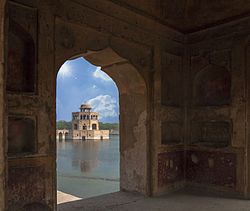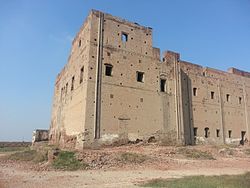Sheikhupura District
Sheikhupura District ضلع شیخوپورا ضلع شیخوپورہ | |
|---|---|
 Map of Sheikhupura District highlighted | |
| Country | |
| Province | |
| Division | Lahore |
| Headquarters | Sheikhupura |
| Government | |
| • Type | District Administration |
| • Deputy Commissioner | Mr. Shahid Imran Marth |
| • District Police Officer | N/A |
| • District Health Officer | N/A |
| Area | |
| 3,744 km2 (1,446 sq mi) | |
| Population (2023)[1] | |
| 4,049,418 | |
| • Density | 1,100/km2 (2,800/sq mi) |
| • Urban | 1,550,793 |
| • Rural | 2,498,625 |
| Literacy | |
| • Literacy rate |
|
| Time zone | UTC+5 (PST) |
| Area code | 056 |
| Tehsils | Sheikhupura Ferozewala Muridke Sharaq Pur Safdarabad |
Sheikhupura District (Punjabi: ضلع شیخوپورا; Urdu: ضلع شيخوپورہ), is a district located in Lahore Division of Punjab Province, Pakistan. Sheikhupura is the headquarters of Sheikhupura district. According to the 1998 census of Pakistan, the district had a population of 3,321,029 of which 25.45% were urban.[3] In 2005 one of its subdivisions was split off to form the new Nankana Sahib District.[4]
According to the 2017 Census of Pakistan, most populous cities of the district are Sheikhupura, Muridke, Kot Abdul Malik and Ferozewala. All these four cities are listed in the List of most populous cities in Pakistan.
Administration
The district comprises five tehsils:[4]
| Tehsil[5] | Area
(km²)[6] |
Pop.
(2023) |
Density
(ppl/km²) (2023) |
Literacy rate
(2023)[7] |
Union Councils |
|---|---|---|---|---|---|
| Muridke | 1,028 | 721,192 | 701.55 | 69.10% | ... |
| Ferozewala | 511 | 997,246 | 1,951.56 | 66.55% | ... |
| Safdarabad | 461 | 320,851 | 695.99 | 67.55 % | ... |
| Sheikhupura | 1,369 | 1,780,837 | 1,300.83 | 70.72% | ... |
| Sharak Pur | 375 | 229,292 | 611.45 | 65.05% | ... |
Committees
List of Municipal Committees in District Sheikhupura
- Sheikhupura Municipal Committee
- Farooq abad Municipal Committee
- Mananwala Municipal Committee
- Safdar abad Municipal Committee
- Khanqah dogran Municipal Committee
- Ferozwala Municipal Committee
- Kot Abdulmalik Municipal Committee
- Muridke Municipal Committee
- Narang Mandi Municipal Committee
- Sharaqpur Municipal Committee
Demographics
Population
| Year | Pop. | ±% p.a. |
|---|---|---|
| 1998 | 2,276,164 | — |
| 2017 | 3,460,004 | +2.23% |
| 2023 | 4,049,418 | +2.66% |
| Sources:[8] | ||
As of the 2023 census, Sheikhupura district has 593,260 households and a population of 4,049,418. The district has a sex ratio of 105.58 males to 100 females and a literacy rate of 68.88%: 72.09% for males and 65.46% for females.[9][10] 1,087,191 (26.85% of the surveyed population) are under 10 years of age.[11] 1,550,793 (38.30%) live in urban areas.[9]
Religion
| Religious group |
1941[12][a] | 2017[13] | 2023[14] | |||
|---|---|---|---|---|---|---|
| Pop. | % | Pop. | % | Pop. | % | |
| Islam |
326,042 | 60.54% | 3,325,148 | 96.30% | 3,896,801 | 96.23% |
| Sikhism |
109,276 | 20.29% | — | — | 85 | ~0% |
| Hinduism |
56,378 | 10.47% | 323 | 0.01% | 820 | 0.02% |
| Christianity |
46,737 | 8.68% | 130,405 | 3.77% | 148,784 | 3.67% |
| Ahmadiyya |
— | — | 3,656 | 0.11% | 2,638 | 0.07% |
| Others | 151 | 0.02% | 472 | 0.01% | 334 | 0.01% |
| Total Population | 538,584 | 100% | 3,460,004 | 100% | 4,049,377 | 100% |
| Religious group |
1921[15] | 1931[16] | 1941[12] | |||
|---|---|---|---|---|---|---|
| Pop. | % | Pop. | % | Pop. | % | |
| Islam |
330,880 | 63.25% | 445,996 | 64.01% | 542,344 | 63.62% |
| Hinduism |
85,781 | 16.4% | 81,887 | 11.75% | 89,182 | 10.46% |
| Sikhism |
82,965 | 15.86% | 119,477 | 17.15% | 160,706 | 18.85% |
| Christianity |
23,431 | 4.48% | 49,266 | 7.07% | 60,054 | 7.04% |
| Jainism |
78 | 0.01% | 100 | 0.01% | 221 | 0.03% |
| Zoroastrianism |
0 | 0% | 6 | 0% | 1 | 0% |
| Judaism |
0 | 0% | 0 | 0% | 0 | 0% |
| Buddhism |
0 | 0% | 0 | 0% | 0 | 0% |
| Others | 0 | 0% | 0 | 0% | 0 | 0% |
| Total population | 523,135 | 100% | 696,732 | 100% | 852,508 | 100% |
| Note1: British Punjab province era district borders are not an exact match in the present-day due to various bifurcations to district borders — which since created new districts — throughout the historic Punjab Province region during the post-independence era that have taken into account population increases. Note2:District created between Gujranwala District, Sialkot District, Amritsar District, Lahore District, Montgomery District, and Lyallpur District in 1920 to account for the large population increase in the region, primarily due to the Chenab Canal Colony. | ||||||
| Tehsil | Islam |
Hinduism |
Sikhism |
Christianity |
Jainism |
Others[c] | Total | |||||||
|---|---|---|---|---|---|---|---|---|---|---|---|---|---|---|
| Pop. | % | Pop. | % | Pop. | % | Pop. | % | Pop. | % | Pop. | % | Pop. | % | |
| Khangah Dogran Tehsil | 149,478 | 55.84% | 47,291 | 17.67% | 52,581 | 19.64% | 18,262 | 6.82% | 62 | 0.02% | 0 | 0% | 267,674 | 100% |
| Sharakpur Tehsil | 181,402 | 71.01% | 38,490 | 15.07% | 30,384 | 11.89% | 5,169 | 2.02% | 16 | 0.01% | 0 | 0% | 255,461 | 100% |
| Note: British Punjab province era tehsil borders are not an exact match in the present-day due to various bifurcations to tehsil borders — which since created new tehsils — throughout the historic Punjab Province region during the post-independence era that have taken into account population increases. | ||||||||||||||
| Tehsil | Islam |
Hinduism |
Sikhism |
Christianity |
Jainism |
Others[d] | Total | |||||||
|---|---|---|---|---|---|---|---|---|---|---|---|---|---|---|
| Pop. | % | Pop. | % | Pop. | % | Pop. | % | Pop. | % | Pop. | % | Pop. | % | |
| Sheikhupura Tehsil | 201,401 | 53.48% | 45,690 | 12.13% | 94,882 | 25.2% | 34,359 | 9.12% | 211 | 0.06% | 46 | 0.01% | 376,589 | 100% |
| Nankana Sahib Tehsil | 174,787 | 74.33% | 22,631 | 9.62% | 31,562 | 13.42% | 6,157 | 2.62% | 8 | 0% | 0 | 0% | 235,145 | 100% |
| Shahdara Tehsil | 166,156 | 69.01% | 20,861 | 8.66% | 34,262 | 14.23% | 19,469 | 8.09% | 2 | 0% | 24 | 0.01% | 240,774 | 100% |
| Note1: British Punjab province era tehsil borders are not an exact match in the present-day due to various bifurcations to tehsil borders — which since created new tehsils — throughout the historic Punjab Province region during the post-independence era that have taken into account population increases. Note2: Tehsil religious breakdown figures for Christianity only includes local Christians, labeled as "Indian Christians" on census. Does not include Anglo-Indian Christians or British Christians, who were classified under "Other" category. | ||||||||||||||
Language
At the time of the 2023 census, 93.40% of the population spoke Punjabi, 4.89% Urdu and 0.95% Pashto as their first language.[17] The Majhi dialect is the predominant dialect here. In 1998, 98.1% of the population spoke Punjabi.[17]
Notable people
- Dhani Ram Chatrik, an influential punjabi poet
- Ganga Ram, civil engineer and architect
- Kulwant Singh Virk, an author in Punjabi and English language
See also
- Sharaqpur Sharif
- Hiran Minar
- Sheikhupura Fort
- Tehsils of Punjab, Pakistan
- Tehsils of Pakistan
- Districts of Pakistan
References
- ^ a b c "District Wise Results / Tables (Census - 2023)" (PDF). www.pbscensus.gov.pk. Pakistan Bureau of Statistics.
- ^ "Literacy rate, enrolments, and out-of-school population by sex and rural/urban, CENSUS-2023" (PDF).
- ^ Urban Resource Centre (1998 Census) Archived 2006-05-13 at the Wayback Machine
- ^ a b "Sheikhupura - Punjab Portal". Retrieved 13 December 2016.
- ^ Divisions/Districts of Pakistan Archived 2006-09-30 at the Wayback Machine Note: Although divisions as an administrative structure has been abolished, the election commission of Pakistan still groups districts under the division names
- ^ "TABLE 1 : AREA, POPULATION BY SEX, SEX RATIO, POPULATION DENSITY, URBAN POPULATION, HOUSEHOLD SIZE AND ANNUAL GROWTH RATE, CENSUS-2023, PUNJAB" (PDF).
- ^ "LITERACY RATE, ENROLMENT AND OUT OF SCHOOL POPULATION BY SEX AND RURAL/URBAN, CENSUS-2023" (PDF).
- ^ "Population by administrative units 1951-1998" (PDF). Pakistan Bureau of Statistics.
- ^ a b "7th Population and Housing Census - Detailed Results: Table 1" (PDF). Pakistan Bureau of Statistics.
- ^ "7th Population and Housing Census - Detailed Results: Table 12" (PDF). Pakistan Bureau of Statistics.
- ^ "7th Population and Housing Census - Detailed Results: Table 5" (PDF). Pakistan Bureau of Statistics.
- ^ a b c "Census of India, 1941. Vol. 6, Punjab". 1941. p. 42. JSTOR saoa.crl.28215541. Retrieved 23 March 2024.
- ^ "Final Results (Census-2017)". Retrieved 23 March 2024.
- ^ "Pakistan Census 2023" (PDF).
- ^ a b "Census of India 1921. Vol. 15, Punjab and Delhi. Pt. 2, Tables". 1921. p. 29. JSTOR saoa.crl.25430165. Retrieved 23 March 2024.
- ^ "Census of India 1931. Vol. 17, Punjab. Pt. 2, Tables". 1931. p. 277. JSTOR saoa.crl.25793242. Retrieved 23 March 2024.
- ^ a b 1998 District Census report of Sheikhupura. Census publication. Vol. 79. Islamabad: Population Census Organization, Statistics Division, Government of Pakistan. 2000. pp. 105–6.
- ^ Figures for 1941 are for the Shahdara and part of Sheikupura tehsils of erstwhile Sheikhupura district. Current ratio of population of Sangla Hill and Shahkot tehsils (which were split from Sheikhupura tehsil) to current borders of erstwhile Sheikhupura tehsil were used to estimate 1941 population of rural areas currently in Nankana Sahib district. Sangla Hill town was removed separately and rural areas were assumed to have a uniform distribution of religions.
- ^ a b 1931-1941: Including Ad-Dharmis
- ^ Including Buddhism, Zoroastrianism, Judaism, Tribals, others, or not stated
- ^ Including Anglo-Indian Christians, British Christians, Buddhism, Zoroastrianism, Judaism, Tribals, others, or not stated




